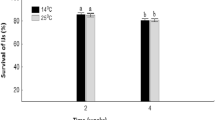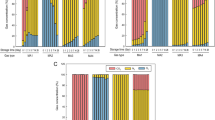Abstract
Pest Management Professionals commonly use polyethylene or fiberglass tanks for mixing and applying termiticides. We investigated the stability of fipronil (Termidor® SC) (0.06%, 0.09% and 0.125% active ingredient) in aqueous solutions stored in polyethylene tanks under sun and shade for 2 week. Chemical analysis of tank-mixed solutions sampled at 0, 24, 48, 72, 168 and 336 h indicated that fipronil remained stable. Our data indicated that polyethylene tanks prevent fipronil from photodegradation and these tanks can be safely used for short term storage (up to 2 week) of liquid termiticides.



Similar content being viewed by others
References
Cole LM, Nicholson RA, Casida JE (1993) Action of phenyl pyrazole insecticide at the GABA-Gated chloride channel. Pestic Biochem Physiol 46:1–47. doi:10.1006/pest.1993.1035
Connelly P (2006) Environmental fate of fipronil. Environmental Monitoring. Department of Pesticide Regulation, Sacramento CA, pp 1–17
Gold RE, Howell HN, Pawson BM Jr, Wright MS, Lutz JC (1996) Persistence and bioavailability of termiticides to subterranean termites (Isoptera: Rhinotermitidae from soil types and locations in Texas. Sociobiology 28:337–364
Hainzl D, Casida JE (1996) Fipronil insecticide: novel photochemical desulfinylation with retention of neurotoxicity. Proc Natl Acad Sci USA 93:12764–12767. doi:10.1073/pnas.93.23.12764
Kamble ST (2006) Termites. Nebraska Cooperative Extension, NebGuide 1062, University of Nebraska, Lincoln, NE 68583, USA, p 4
SAS Institute (2002) SAS procedures guide for personal computers. SAS Institute, Cary
Tingle CCD, Rother JA, Dewhurst CF, Lauer S, King WJ (2003) Fipronil: environmental fate, ecotoxicology, and human health concerns. Rev Environ Contam Toxicol 176:1–66
USEPA (1996) Fipronil pesticide fact sheet. EPA 737-F-96-005. USEPA, Washington, DC, p 7
USEPA (1998) Fipronil for use on rice (Regent®, Icon®) and pets (Frontline®). HED Risk Assessment. Office of Prevention, Pesticides and Toxic Substances, USEPA, Washington, DC, p 90
Acknowledgments
We are grateful to BASF Inc. for supplying the Termidor® SC used in this study. We thank Drs. Robert Wright and Steve Danielson for reviewing an earlier version of this manuscript and Dr. Stephen Kachman for assistance with statistical analysis. This is published as contribution no. 1291, Department of Entomology-Institute of Agriculture and Natural Resources, University of Nebraska- Lincoln.
Author information
Authors and Affiliations
Corresponding author
Rights and permissions
About this article
Cite this article
Husen, T.J., Spomer, N.A. & Kamble, S.T. Degradation of Fipronil (Termidor®) in Aqueous Solution Stored in Polyethylene Tanks Exposed to Sunlight or Shade. Bull Environ Contam Toxicol 82, 605–609 (2009). https://doi.org/10.1007/s00128-009-9651-6
Received:
Accepted:
Published:
Issue Date:
DOI: https://doi.org/10.1007/s00128-009-9651-6




